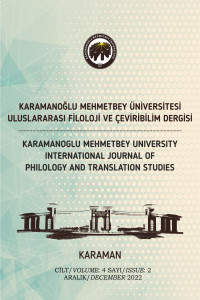ARCHAEOLOGY AS A SPECIALIZED FIELD OF TRANSLATION: A PRELIMINARY LESSON PLAN IN TERMINOLOGY TRANSLATION PRACTICE
Öz
Bu çalışma, öteden beri disiplinlerarası bir alan olarak tanımlanan Çeviribilimin disiplinlinlerarası temellerinden hareketle Çeviribilim ile arkeoloji alanları arasındaki ilişkiye odaklanmakta ve bu alanda eğitim gören öğrencilerin terim çevirisi stratejileri ile tanışmasına ön ayak olacak bir metnin ders içi çeviri uygulamasına ilişkin öncül bir çerçeve çizmektedir. Çalışma üç bölümden oluşmaktadır. Birinci bölümde çeviribilimin disiplinlerarası yanları; ikinci bölümde, çeviribilim alanında arkeoloji metinlerine olan yaklaşım ve söz konusu özel alanda çeviri uygulamasına ilişkin düşünceler; üçüncü bölümde ise bir özel alan çevirisi dersinde çevrilmek üzere seçilen arkeoloji alanında bir metnin potansiyel kullanımları tartışılmaktadır. Çalışmada, çeviri eğitiminde arkeoloji metinleri yoluyla edinilen arkeoloji metinleri yoluyla edinilen arka plan bilgisinin ve terim çevirisi deneyiminin, öğrencilerin diğer özel alan metinlerinin çevirisine ilişkin farkındalığını geliştirme ve dünyadaki diğer kültürlere ilişkin bakış açısını genişletme potansiyeli taşıdığı sonucuna ulaşılmıştır.
Anahtar Kelimeler
Disiplinlerarasılık çeviribilim arkeoloji özel alan çevirisi terim çevirisi.
Kaynakça
- Alizadeh, A. (2011). Bridging cultures: Tourism and the art of translation. 2011 International Conference on Social Science and Humanity IPEDR 5, 261-264.
- Alvarez, R. & Vidal, M. C. (1996). Translating: A Political Act. Translation, Power, Subversion (Eds. Roman Alvarez, M. Carmen-Africa Vidal), 1-9. Philadelphia, the USA: Multilingual Matters Ltd.
- Bassnett, S. & Lefevere, A. (1990). Translation, History and Culture. London, the UK: Printer Publishers.
- Catford, J. C. (1965). A Linguistic Theory of Translation: An Essay in Applied Linguistics. Oxford, the UK: Oxford University Press.
- Cronin, M. (2010). Globalization and translation. Handbook of Translation Studies (Eds. Yves Gambier, Luc van Doorslaer), 134-140. London, the UK: Routledge.
- Dietsch, D. K. & Stern, R. A. M. (2021, 16 December) Greek Architecture: Doric, Ionic, or Corinthian? Architecture for Dummies. https://www.dummies.com/article/academics-the-arts/art-architecture/architecture/greek-architecture-doric-ionic-or-corinthian-201218/
- Gentzler, E. (2014). Translation Studies: Pre-Discipline, Discipline, Interdiscipline, and Post-Discipline. International Journal of Society, Culture and Language (IJSCL), 13-24.
- Graedler, A. L. (2010). Cultural shock. Oslo Studies in English on the Net - Translation course. University of Oslo. Web. Access: 2 June 2012
- Guerra, A. F. (2012). Translating culture: problems, strategies and practical realities. [sic] - a journal of literature, culture and literary translation 12/1, 1-27.
- Holmes, J. S. (1988). The Name and Nature of Translation Studies. Translated! Papers on Literary Translation and Translation Studies, 66-80, Amsterdam, the Netherlands: Rodopi.
- Jakobson, R. (1959). On Linguistic Aspects of Translation, On Translation (Ed. Reuben A. Browner), 232–239. Massachusetts, the USA: Harvard University Press. Lee, S. (2010). Cultural Heritage and Translation: Rethinking Website Information of Palaces. Journal of Language & Translation, 11/1, 73-90.
- Nida, E. (1969). The Theory and Practice of Translation, Boston, the USA: Brill.
- O’Brien, S. (2015). The borrowers: Researching the cognitive aspects of translation. Interdisciplinarity in Translation and Interpreting Process Research, 5-17, Amsterdam, the Netherlands; Philadelphia, the USA: John Benjamins Publishing Company.
- Pym, A. (2006). Globalization and the Politics of Translation Studies. Meta 51(4), 744–757.
- Reiss, K. & Vermeer, H. (1984/2014). Towards a General Theory of Translational Action: Skopos Theory Explained (Trans. Christiane Nord). New York, the USA: Routledge.
- Richardson, M. (2001). Translation as a Means of Cultural Transmission. Crossing Cultural Borders, Toward an Ethics of Intercultural Communication – Beyond Reciprocal Anthropology, 267-286. Tokyo, Japan: International Research Center for Japanese Studies.
- Ruano, M. R. M. (2006). Conciliation of disciplines and paradigms: A challenge and a barrier for future directions in translation studies.” Translation Studies at the Interface of Disciplines, 43-54. Amsterdam, the Netherlands; Philadelphia, the USA: John Benjamins Publishing Company.
- Sanning, H. (2010). Lost and Found in Translating Tourist Texts: Domesticating, Foreignising or Neutralising Approach. The Journal of Specialised Translation 13, 124-137.
- Snell-Hornby, M. (2006). The Turns of Translation Studies. Amsterdam, the Netherlands; Philadelphia, the USA: John Benjamins Publishing Company.
- Szal, M. (2014). Translating Cultural Elements in Specialised Texts. Zeszytynaukowe Uniwersytetu Rzeszowskiego Seria Filologiczna Studia Anglica Resoviensia 11, 72-80.
- Tymoczko, M. & Gentzler, E. (Eds.). (2002). Translation and Power. University of Massachusetts Press/Beijing: Foreign Language Teaching and Research Press.
- Venuti, L. (1995). The Translator’s Invisibility: A History of Translation. London, the UK: Routledge.
- Vermeer, H. J. (1978). Ein Rahmen für eine allgemeine Translationstheorie. Lebende Sprachen 23, 99-102.
- Yazıcı, M. (2009). Translation Studies as a Fully-Fledged Discipline. Perspectives in Translation Studies, 6-19. Newcastle upon Tyne, the UK: Cambridge Scholars Publishing.
ARCHAEOLOGY AS A SPECIALIZED FIELD OF TRANSLATION: A PRELIMINARY LESSON PLAN IN TERMINOLOGY TRANSLATION PRACTICE
Öz
This study focuses on relations between archaeology as a specialized field of translation and Translation Studies as an interdisciplinary area and draws a framework for a preliminary lesson plan in terminology translation practice through a text that will allow Translation Studies students to get acquainted with term translation strategies in a specialized translation course on archaeology. This study consists of three parts. In the first part, interdisciplinary aspects of translation studies are analyzed from the perspective of different turns in translation research. In the second part, approaches to archaeology texts in translation studies and thoughts on translation practice in this field are brought forward, while the potential uses of a text in archaeology for a specialized translation course are evaluated in the third part. In the study, it has been concluded that background knowledge and terminology translation practice in archaeology texts have the potentials to improve students’ awareness with regards to translation of other specialized texts and to enhance their perspectives on other cultures in the world.
Anahtar Kelimeler
Interdisciplinarity translation studies archaeology specialized translation terminology translation.
Kaynakça
- Alizadeh, A. (2011). Bridging cultures: Tourism and the art of translation. 2011 International Conference on Social Science and Humanity IPEDR 5, 261-264.
- Alvarez, R. & Vidal, M. C. (1996). Translating: A Political Act. Translation, Power, Subversion (Eds. Roman Alvarez, M. Carmen-Africa Vidal), 1-9. Philadelphia, the USA: Multilingual Matters Ltd.
- Bassnett, S. & Lefevere, A. (1990). Translation, History and Culture. London, the UK: Printer Publishers.
- Catford, J. C. (1965). A Linguistic Theory of Translation: An Essay in Applied Linguistics. Oxford, the UK: Oxford University Press.
- Cronin, M. (2010). Globalization and translation. Handbook of Translation Studies (Eds. Yves Gambier, Luc van Doorslaer), 134-140. London, the UK: Routledge.
- Dietsch, D. K. & Stern, R. A. M. (2021, 16 December) Greek Architecture: Doric, Ionic, or Corinthian? Architecture for Dummies. https://www.dummies.com/article/academics-the-arts/art-architecture/architecture/greek-architecture-doric-ionic-or-corinthian-201218/
- Gentzler, E. (2014). Translation Studies: Pre-Discipline, Discipline, Interdiscipline, and Post-Discipline. International Journal of Society, Culture and Language (IJSCL), 13-24.
- Graedler, A. L. (2010). Cultural shock. Oslo Studies in English on the Net - Translation course. University of Oslo. Web. Access: 2 June 2012
- Guerra, A. F. (2012). Translating culture: problems, strategies and practical realities. [sic] - a journal of literature, culture and literary translation 12/1, 1-27.
- Holmes, J. S. (1988). The Name and Nature of Translation Studies. Translated! Papers on Literary Translation and Translation Studies, 66-80, Amsterdam, the Netherlands: Rodopi.
- Jakobson, R. (1959). On Linguistic Aspects of Translation, On Translation (Ed. Reuben A. Browner), 232–239. Massachusetts, the USA: Harvard University Press. Lee, S. (2010). Cultural Heritage and Translation: Rethinking Website Information of Palaces. Journal of Language & Translation, 11/1, 73-90.
- Nida, E. (1969). The Theory and Practice of Translation, Boston, the USA: Brill.
- O’Brien, S. (2015). The borrowers: Researching the cognitive aspects of translation. Interdisciplinarity in Translation and Interpreting Process Research, 5-17, Amsterdam, the Netherlands; Philadelphia, the USA: John Benjamins Publishing Company.
- Pym, A. (2006). Globalization and the Politics of Translation Studies. Meta 51(4), 744–757.
- Reiss, K. & Vermeer, H. (1984/2014). Towards a General Theory of Translational Action: Skopos Theory Explained (Trans. Christiane Nord). New York, the USA: Routledge.
- Richardson, M. (2001). Translation as a Means of Cultural Transmission. Crossing Cultural Borders, Toward an Ethics of Intercultural Communication – Beyond Reciprocal Anthropology, 267-286. Tokyo, Japan: International Research Center for Japanese Studies.
- Ruano, M. R. M. (2006). Conciliation of disciplines and paradigms: A challenge and a barrier for future directions in translation studies.” Translation Studies at the Interface of Disciplines, 43-54. Amsterdam, the Netherlands; Philadelphia, the USA: John Benjamins Publishing Company.
- Sanning, H. (2010). Lost and Found in Translating Tourist Texts: Domesticating, Foreignising or Neutralising Approach. The Journal of Specialised Translation 13, 124-137.
- Snell-Hornby, M. (2006). The Turns of Translation Studies. Amsterdam, the Netherlands; Philadelphia, the USA: John Benjamins Publishing Company.
- Szal, M. (2014). Translating Cultural Elements in Specialised Texts. Zeszytynaukowe Uniwersytetu Rzeszowskiego Seria Filologiczna Studia Anglica Resoviensia 11, 72-80.
- Tymoczko, M. & Gentzler, E. (Eds.). (2002). Translation and Power. University of Massachusetts Press/Beijing: Foreign Language Teaching and Research Press.
- Venuti, L. (1995). The Translator’s Invisibility: A History of Translation. London, the UK: Routledge.
- Vermeer, H. J. (1978). Ein Rahmen für eine allgemeine Translationstheorie. Lebende Sprachen 23, 99-102.
- Yazıcı, M. (2009). Translation Studies as a Fully-Fledged Discipline. Perspectives in Translation Studies, 6-19. Newcastle upon Tyne, the UK: Cambridge Scholars Publishing.
Ayrıntılar
| Birincil Dil | İngilizce |
|---|---|
| Bölüm | Araştırma Makaleleri |
| Yazarlar | |
| Yayımlanma Tarihi | 30 Aralık 2022 |
| Gönderilme Tarihi | 15 Haziran 2022 |
| Kabul Tarihi | 30 Eylül 2022 |
| Yayımlandığı Sayı | Yıl 2022 Cilt: 4 Sayı: 2 |
422x119
Articles published in this journal are licensed under Creative Commons Attribution 4.0 International license. This journal does not charge APCs or submission charges. Articles published in this journal are permanently free for everyone to read, download, copy, distribute, print, search and link to the full texts of these articles. |












